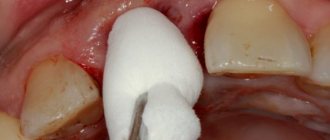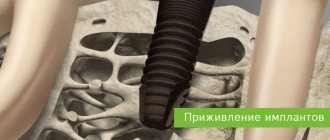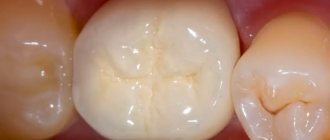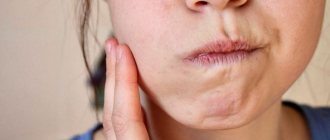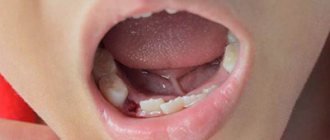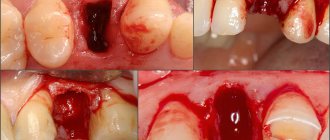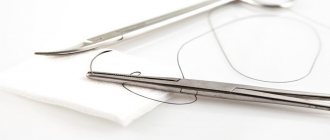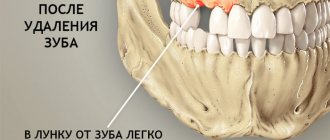Suturing the gums after tooth extraction: when required
On the eve of a surgical operation, patients are often interested in whether it is necessary to apply sutures after removing a tooth - wisdom, canine, incisor. There are certain indications for gum suturing:
- Dental implantation. When choosing a one-stage tooth restoration protocol, the patient must undergo two surgical interventions at once. This is tooth extraction and immediate implantation. In order for the dental implant to take root in the bone tissue without any problems, the doctor will apply sutures and leave the implant in the tooth socket.
- Removing eights. Wisdom teeth are characterized by enlarged roots, an uncomfortable position in the jaw row, and difficulty in extraction. When third molars are removed, soft and bone tissues are severely damaged, heavy bleeding begins, and severe pain is possible. To reduce unpleasant consequences, the doctor places a hemostatic sponge in the hole and sutures the gums after tooth extraction.
Sutures are also indicated when there is a threat of severe bleeding, extraction of dystopic and impacted teeth. The manipulation is also performed at the patient’s personal request.
Features of the procedure
After the wound at the implant site has completely healed, the surgeon can begin to remove the threads. For the peace of mind of the doctor and the patient, it is recommended to do this with pain relief. Lidocaine-based drugs are most often used for this. Just surface treatment of the gums without injections is enough; gel formulas are ideal for this.
Even a doctor’s assistant can remove the stitches; there is nothing complicated in this procedure, and it takes no more than 5-10 minutes. First, the oral cavity is treated with an antimicrobial agent, and then an anesthetic is applied. The sutures are removed using small tweezers. At this time, the specialist can evaluate the result of the work he has done, and also make sure that there are no complications.
At the end of the procedure, a sterile bandage is applied to the surface of the gum, and the oral cavity is disinfected again. But even after the threads are removed, certain rules should be followed: do not eat too hot or cold food, alcohol, do not smoke and do not get involved in active sports. This is the only way the implant can take root as quickly as possible.
Why did you sew up the hole after tooth extraction?
If stitches were applied after wisdom tooth removal, this will only be beneficial. Repeated studies have proven that a sutured socket is:
- reducing the risk of infection and complications - by 90%;
- rapid stop of bleeding;
- preservation of the blood clot and natural healing of the wound;
- minimal pain after surgery;
- rapid fusion of tissues thanks to sutures.
Sutures are placed on the socket immediately after the removal operation. After which the doctor gives recommendations for accelerated healing and rapid normalization of the general condition.
Types of seams and suture materials
The patient’s further actions depend on what materials and suturing technique the surgeon used in dentistry. There are seams:
- Intermittent - stitches are applied separately, each secured with its own knot. Damage to one stitch does not affect the integrity of the others, allowing you to keep the hole closed.
- Continuous - all stitches are made with one suture thread and have a common knot. If one stitch is damaged, the entire seam comes apart.
Features of suture material:
- Absorbable threads are a sterile material of natural or synthetic composition, which after some time disintegrates into independent elements. During the healing process of the hole, the sutures securely fix the wound and then completely dissolve.
- Non-absorbable compounds are common synthetic threads used by dental surgeons in their work. These are polyester, nylon, silk, monofilament.
The material and features of suturing influence how the sutures are removed after the removal of a wisdom tooth or another unit.
Classification of seams
After tearing out the “eight”, at the discretion of the dental surgeon, regular and self-absorbing sutures can be applied.
In the first case, we are talking about materials that cannot dissolve on their own. These are silk, nylon, polyester. Such threads are not absorbed. They securely hold the edges of the wound until the doctor removes them. Self-absorbable material is absorbable. Its main advantage is that the patient does not have to visit the doctor again to have his stitches removed. The latter disappear without a trace on their own.
There are two types of self-absorbable threads:
- Absorbable due to hydrolysis reaction. These include Dexon and Vicryl threads. They are synthetic and do not cause allergic reactions. The edges of the wound are securely held for about one month.
- Absorbable due to the influence of enzymes. We are talking about Catgut. Its particles are quickly eliminated from the human body. Catgut is used for complex dental operations. But it is important to consider that it contains foreign proteins that can cause inflammation.
There is no need to think that suture materials dissolve without a trace. They simply break down into tiny particles that a person spits out or swallows. These particles are non-toxic and therefore cannot cause poisoning.
We sewed up the gum after tooth extraction: when to remove the sutures
Removal of sutures from the gums after tooth extraction is carried out 7-10 days after surgery. The doctor invites you to a follow-up appointment. When examining the patient’s oral cavity, the dentist notes the quality of wound healing and the general condition of the tissues in the area of the extracted tooth.
If healing goes well, the stitches will be removed on the same day.
How long does it take for sutures to dissolve after tooth extraction?
We sewed up the gum after tooth extraction - when the stitches dissolve depends on the material. There are many factors that determine the rate of natural destruction:
- composition - synthetic and natural;
- method of production of threads - what affects the breakdown of the composition;
- individual characteristics of the patient’s body - in particular the state of the immune system;
- the composition of saliva - destruction occurs under its influence.
There are approximate guidelines for when sutures dissolve after wisdom tooth removal, depending on the composition:
- 20-30 days - synthetic self-absorbing sutures after tooth extraction;
- 10-100 days - absorbable materials based on enzymes.
Hygienic oral care after suture removal
To quickly restore the integrity of the soft tissue of the oral cavity, the patient must:
- Use a soft toothbrush to brush your teeth daily;
- use anti-inflammatory rinses;
- rinse the mouth with warm water or a decoction of medicinal herbs after each meal;
- Avoid eating hard, sour, salty, spicy foods that can irritate the mucous membrane.
Timely removal of sutures, maintaining oral hygiene, and performing procedures prescribed by the dentist will ensure good wound healing and speed up recovery.
How to remove suture threads from a tooth socket
Many people associate the removal of sutures with unpleasant pain. Pain occurs only in people with a low pain threshold, increased sensitivity, or when there is inflammation in the tooth socket. Usually the patient experiences only discomfort.
Stages of removing suture material:
- treating the patient's oral cavity with an antiseptic;
- examination of the mucous membranes for hyperthermia, swelling, suppuration;
- the use of topical anesthesia to prevent even minimal pain;
- cutting the threads with a special dental instrument - the stitches are divided in half, especially in the case of an intermittent suture line;
- removing pieces of thread with tweezers;
- checking the density of the scar and the quality of wound healing.
Next, the patient will be asked to rinse his mouth with an antiseptic composition.
The first three days after the stitches are removed, stiffness of movements and discomfort when opening the mouth are possible.
Complications: what to look out for
Even a sutured hole can become a source of problems or inflammation. The patient monitors the condition himself and should consult a doctor if any alarming symptoms appear:
- Heavy bleeding - for a day or more.
- Continuous pain - throbbing, especially severe at night or while eating.
- Swelling is gumboil in the area of tooth extraction.
- Redness is not only a change in the color of the gums, but also redness on the face in the projection of the extraction area.
- Blood in saliva - in the first three days after surgery.
- Increase in body temperature.
The listed symptoms indicate pathological processes and require urgent consultation with a doctor. After the examination, the doctor will prescribe treatment and decide on re-suturing.
Why do the sutures hurt after tooth extraction?
Unpleasant sensations accompany patients during the first hours after tooth extraction. Traumatic surgery requires some time for the body to recover. When the hole is sutured, the rehabilitation process goes faster, but complications also occur.
Alarming symptoms that require consultation with a doctor are as follows:
- bleeding - unexpectedly resumed or continues for more than a day;
- increasing pain - throbbing, radiating to the ear or neck, interfering with sleep and leading a normal lifestyle;
- growing swelling - of soft tissues in the oral cavity or even on the face from the side of the extracted tooth;
- redness and hyperthermia in the surgical area;
- saliva with blood - even several hours after removal;
- high temperature, weakness, general malaise.
Only the attending physician can understand what exactly is happening and what is the reason for feeling unwell. Therefore, at the first sign of discomfort, you need to call the clinic and make an appointment with a doctor.
Recommendations for patients
To ensure that the recovery process takes little time and goes without complications, it is recommended:
- Follow all doctor's orders.
- Do not eat anything for the first few hours after surgery. In the first two to three days after therapy, chew food with the healthy side of the jaw and give preference to soft foods.
- Do not touch the unhealed hole with your hands.
- Do not try to remove a blood clot with your tongue or foreign objects.
- Rinse only if prescribed by a doctor.
- Avoid strenuous physical activity for the first two weeks.
- Do not attempt to remove stitches yourself.
By following these simple rules, a person can quickly return to their normal lifestyle after dental surgery.
